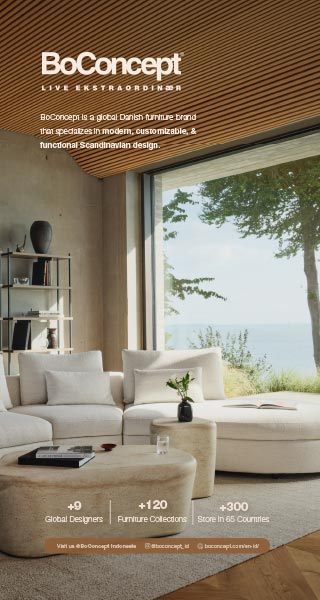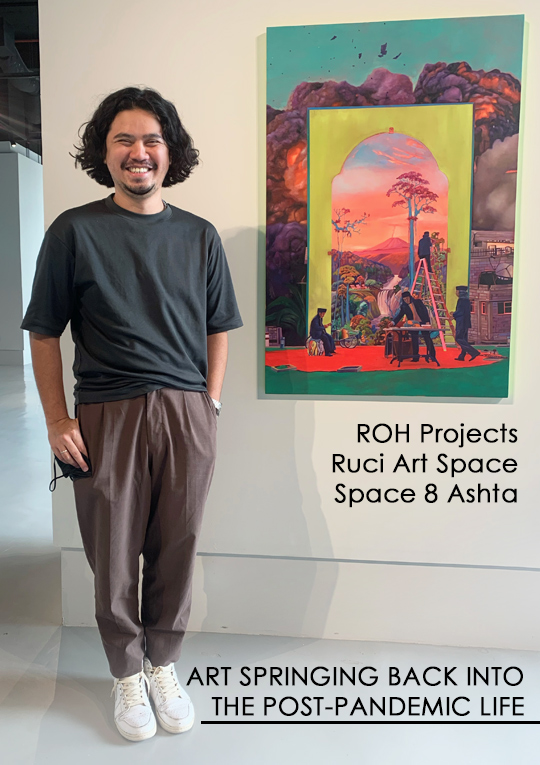
ART SPRINGING BACK INTO THE POST-PANDEMIC LIFE
Published by Sugar & Cream, Thursday 28 April 2022
Images courtesy Lynda Ibrahim & respected galleries
ROH Projects, Ruci Art Space & Space 8 Ashta
For over two years the pandemic has wreaked havoc into countless aspects of life. Besides the ultimate loss of lives, it has also eliminated potentials, eroded progresses and destroyed businesses. Art, seen by public as either secondary or tertiary need, is badly hit by Covid-19 that has public ruthlessly prioritized primary needs.
As the pandemic eased and more public armed with booster shots, the economy is starting to wiggle. This gives way for art to return to the public domain, as seen by the preliminary show of Art Jakarta 2022 that utilized the open space at Plataran Senayan and the burst of activity at art galleries across town. Let’s have a look at the galleries.
ROH Projects
After working nomadic during the pandemic, ROH Projects settled in Central Jakarta. A partially preserved 1950 house, it provides two spaces called Apple and Orange. The works featured on the reopening exhibition were done for the intended space, giving visitors extra sensation from the artwork position, lighting, and wall texture. The high ceiling, natural flooring, white walls and vintage stairs give out a calming yet studious vibe without feeling pretentious—reminds me of Fondazione Prada, the spacious art gallery built by the Prada family at a former distillery in Milan.
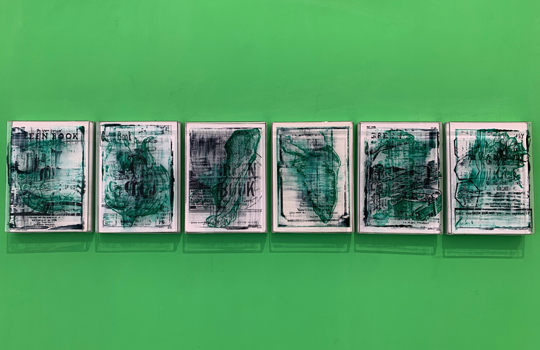
Artwork by Aditya Novali
After being greeted outside by a cheeky work by Uji Handoko, visitors will be greeted by soprano recorder and mic stand installation by Tromarama, while sounds from Bagus Pandega’s installation emanated nearby. For those who’ve survived or lost loved ones due to Covid-19, the pulmonary x-ray hung by Bagus at the heart of his installation would strike a certain chord.
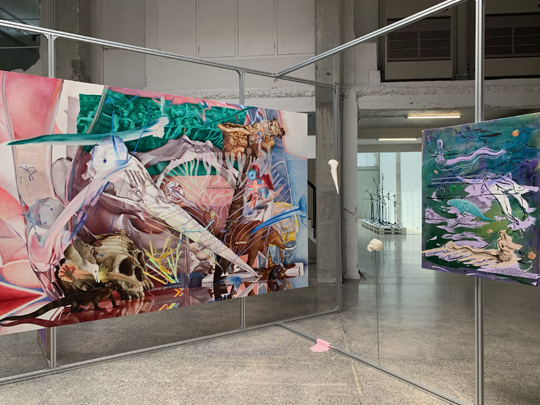
Artwork by Kei Imazu
60 panels by Aditya Novali depicting his myriad of pandemic-related emotions occupy a wall on their own at Apple space, while various contemplations by Kei Imazu, including of mermaids awash in purples, lend vibrance to Orange space. Works from 16 artists can be found throughout the gallery, like the series of work by Nadira Julia on the 2nd floor that can only be viewed from the 1st floor through a wall opening.
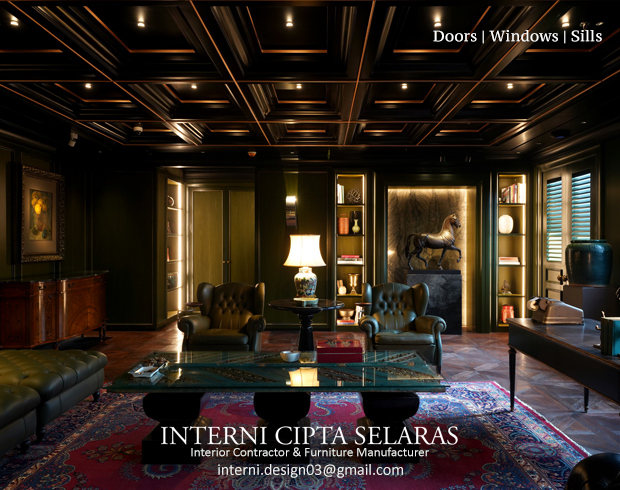
Presented by Interni Cipta Selaras
While other galleries opted for commercial centers, ROH’s new edifice on a leafy riverbank in one of Menteng’s quiet corners synergizes well with its architecture, offering a shelter from the weary world.
Ruci Art Space
Moved last year from their longtime premise in an upscale neighborhood of Kebayoran Baru, Ruci Art Space now operates on top of a hip coffee joint at the heart of Blok M area, giving easier access for Gen Y and Gen Z who’ve been rediscovering tony Blok M in recent years.
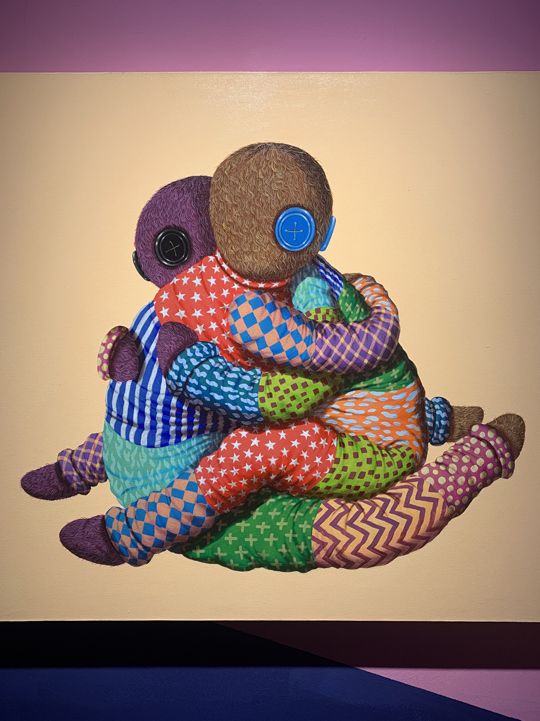
Artwork by Suanjaya Kencut
While other art events are springing this year, Ruci jumped start at the end of 2021 by exhibiting Suanjaya Kencut, a promising Balinese artist whose solo exhibition in Jakarta by early 2019 stole attention. Still working with his trademark of button-eyed creatures, Kencut explored his recent journey that included both worries and excitement of welcoming a new child during the pandemic, putting forth familial unity as another underlying theme. The exhibition was refreshing, a welcome refuge after the prolonged pandemic, that unfortunately was soon shaded by the Omicron wave as 2022 rolled in.
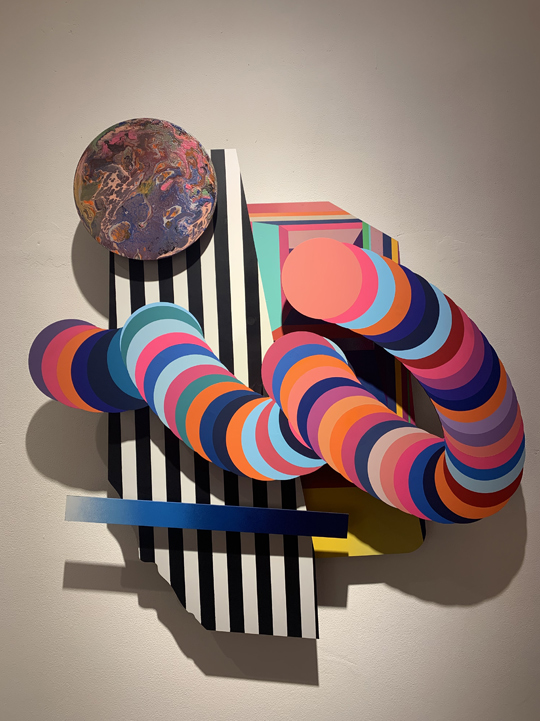
Artwork by Harishazka
Undeterred, Ruci currently holds another solo exhibition. Titled “Past, Present, Future”, the Jakarta-based Harishazka presents a series of neon-colored geometric abstracts in two- and three-dimensional formats, depicting the artist’s internal struggle to find calm in the sea of uncertainty. The concept of fluidity and the feeling of instability can be experienced more intensely through the virtual reality access provided for each work.
Themes, exhibition format and Ruci’s current location have managed to lure in youngsters, slowly breaking down the psychological wall often separated art from the masses who felt that art was hard to understand—a notable factor in Indonesia where art isn’t taught properly in formal education.
Space 8 Ashta
It’s not clear whether Space 8 Ashta is exclusively dedicated to art, yet its current exhibition has successfully attracted the attention of crowd flocking to Ashta, Jakarta’s hippest mall du jour. Curious teens, chic fashionistas, couples with baby strollers are found among the usual art folks at Zico Albaiquni’s solo exhibition.
Zico Albaiquni’s solo exhibition:“Tilem: Disruptive Liminalities” at Space 8 Ashta
Titling it “Tilem: Disruptive Liminalities”, Zico didn’t exactly pick an easy subject. Wrestling with the reality that history, including Indonesian, was often told from colonial European perspective, the artist attempts to reclaim the right to create narratives from the perspective of the colonialized—the people he often saw depicted as cold, nameless and voiceless throughout history books.
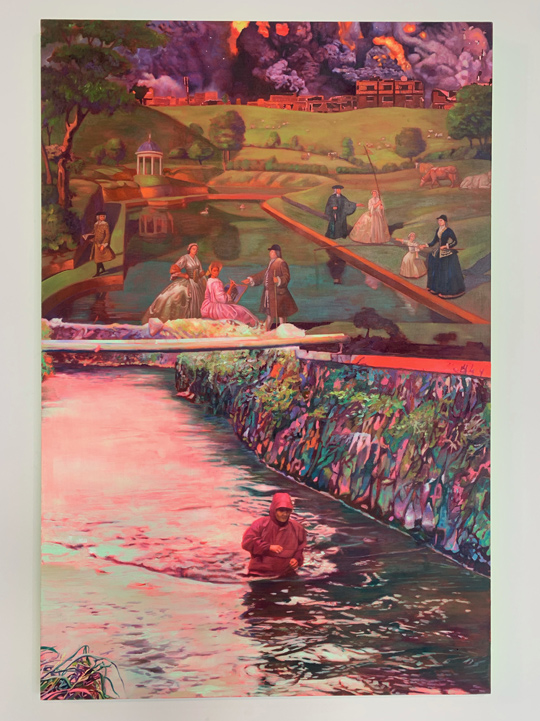
Artwork by Zico Albaiquni
Sifting through literatures, oral knowledge, collective memories, and previous works by accomplished artists, Zico juxtaposes “established” historical moments and colonial cultures with local viewpoints and wisdom, offering a new narrative on each work that he hoped was closer to the reality. In one of his bluntest works, Zico placed European society ladies in a lush garden overlooking a polluted river where an Indonesian man tried wading through, naming the work just as bluntly, “Against the current: You have that privilege and we have to deal with this shit.”
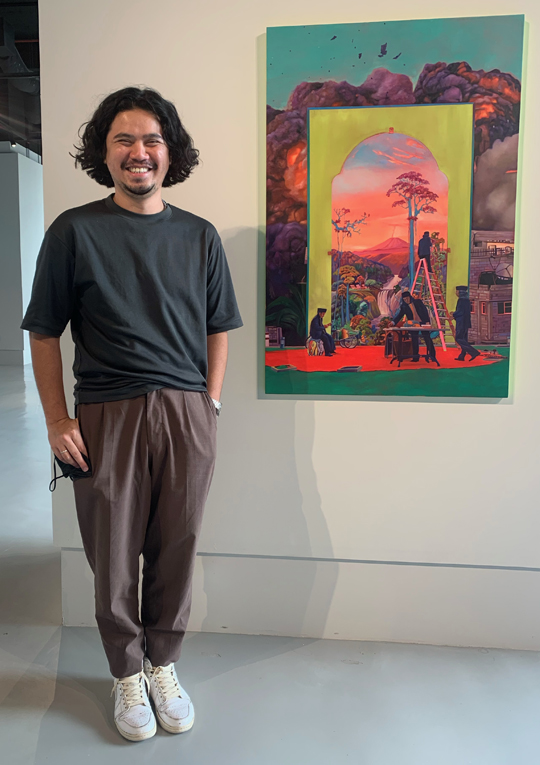
Artis Zico Albaiquni
In another series towards the back of the gallery, Zico portrayed the commodification of yesteryears’ bare-breasted Balinese maidens and general Indonesian beauty—imageries too often glorified by foreign artists throughout 19th and 20th centuries.
The depths of Zico’s challenge against conventional history may or may not translate well to the audience as history lessons in Indonesian formal curriculum has often been about memorizing dates and characters instead of understanding events and discussing their meanings. Zico himself claimed to have enjoyed giving daily tours to walk-ins, mostly mainstream mall rats wandering into the illuminating space at a prominent corner in Ashta, offering them a fresh nugget on history or art.
There is no authority on how the post-pandemic life will look like. Will it simply pick up where it left off in 2019, will it become an entirely new animal, or will it be somewhere in between? No pundits can tell for sure. Either way, it’s comforting to see that art is also returning to the urban scene. Art provides nuances and subtleties, two things to make life less boxed-in and mundane—and after two years of restrained circumstances, art may just be the freedom tonic we direly need. (Lynda Ibrahim)
 1.05K
23/12/2025
1.05K
23/12/2025
SÉANCE, A REFLECTION ON ADRIAN GAN COUTURE’S 40 YEARS IN FASHION
Step into SÉANCE, a reflection on Adrian Gan Couture’s 40 years in fashion—where each gesture is deliberate and every detail refined with impeccable...
read more 576
23/12/2025
576
23/12/2025
OPTIK SEIS X LONGCHAMP EYEWEAR: VERT LUMIÈRE MOMENT
A luminous fashion moment by Optik Seis and Longchamp Eyewear, where Parisian elegance meets a contemporary lifestyle experience at Senayan City.
read more 10.98K
03/12/2025
10.98K
03/12/2025
LIVING DIVANI ILLUMINATES THE FESTIVE SEASON IN SHADES OF DEEP RED AND LUMINOUS SILVER
Living Divani illuminates the festive season in shades of deep red and luminous silver, reimagining its iconic designs with festive radiance.”
read more 10.67K
26/11/2025
10.67K
26/11/2025
MOROSO AT ARTVERONA 2025: DESIGN AS DIALOGUE
Design as language – Moroso’s presence at the heart of ArtVerona’s 20th Edition
read more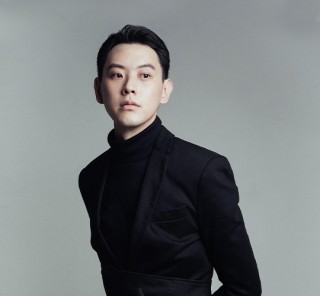 81.54K
10/01/2025
81.54K
10/01/2025
W RESIDENCE IN SOUTH JAKARTA BY MICHAEL CHANDRA
Michael Chandra, founder of MNCO Studio Design has created the W Residence with an aesthetically pleasing, practical, and pleasant home from all...
read more 44.44K
11/07/2025
44.44K
11/07/2025
PELUNCURAN PERDANA LEGANO HOME MENGGANDENG AGAM RIADI DI ST REGIS RESIDENCE JAKARTA
Peluncuran perdana LEGANO HOME menggandeng Agam Riadi di St. Regis Residence Jakarta: menyatukan kemewahan dan jiwa dalam sebuah ruang.
read more





